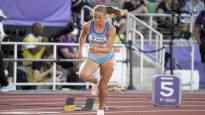Viivi Lehikoinen changed her step rhythm for the semi-final run and ran a new Finnish record. Expert Tuomas Raja considers a place in the final a suitable goal for the European Championships in Munich.
In the preliminaries, Lehikoinen ran a time of 54.95, so he improved the time of the semi-finals by 35 hundredths. Lehikoinen revealed in an interview with that he changed his running rhythm in the semi-finals.
In his SE run, he switched from the usual 15-step rhythm to a 16-step rhythm.
In the heat, Lehikoinen ran the first four hurdles with a rhythm of 15 steps, but in the semifinal he ran only three hurdles with 15 paces. He continued with 16 strides to the seventh fence and came in the final 17 strides in rhythm.
Lehikoinen made the decision together with his coach Laurent Meuwlyn with. According to Aitur, changing the rhythm in the semi-final was a risk.
– I was of the opinion that I have mentally prepared myself for that rhythm, which was in the first round, so it might be a risk. It went really well. The purpose was to find that there are enough bangs to fight at the end. I think it went pretty well, Lehikoinen told Urheilu.
Sports expert Tuomas Raja thought both of Lehikoinen’s runs were very good. He emphasized Lehikoinen’s ability to adapt to changes.
– Viivi is also a skilled runner because he is able to make changes according to the situation and change the plan either in the middle of the race or a little unexpectedly just before the race. It is also a tough sign, Raja emphasizes.
Watch Lehikoinen’s record run in the video below.
Lehikoinen succeeded excellently in the toughest place of the season. The heat run was the third best run of Lehikoinen’s career. In the semi-final, the best of his career and a new Finnish record came.
– He was at his best in this environment. It means that Viiv has developed into an international level athlete. It’s a tough thing after all the difficult and fluctuating years, says Raja.
“Training done speed head first”
Lehikoinen came into the public eye as a young super-promiser when he won gold at the 2015 European Youth Olympic Festivals. This was followed by the under-18 European Championship gold and the under-20 European Championship bronze.
However, the development of the talented athlete declined after the Finnish under-19 record (56.49) run in the summer of 2017. Now he has risen again to top form under the coaching of the Swiss Laurent Meuwly. The duo’s collaboration began at the end of 2020.
– When this new coach came along, the training was done at full speed in a different way than before. Delays have had good foundations, but now the emphasis on speed has brought more power to running. Speed and power have been brought to the fore, says Raja.
The level of the semi-finals was tough, as 53.72 was required in the time comparison for the final competition. Ukraine, who took second place in the first round Anna Ryzhykova however, made it to the final with a time of 54.51.
– Yes, this was the most difficult final qualifier of all time and in that sense it is not easy to get to the final. Tuija Helander was two hundredths slower than the former Finnish record, fifth in the final race at the then world championships, Raja compares.
Lehikoinen was the sixth best among the Europeans who competed in the World Championships. He is ranked eighth among Europeans in this season’s world statistics.
Raja sees that a place in the finals is a suitable goal for Lehikoinen for the European Championships in Munich, which will take place from 15 to 21. August.
– Of course, there are some good Nelonen paddlers who were not at the World Championships and will participate in the European Championships. In Munich, a good goal for Lehikoinen is a place in the final competition, says Raja.
The SE raced by Tuija Helander in 1987 can be seen in the video below.
